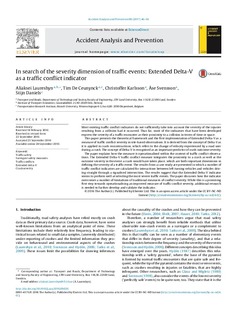| dc.contributor.author | Laureshyn, Aliaksei | |
| dc.contributor.author | De Ceunynck, Tim | |
| dc.contributor.author | Karlsson, Christoffer | |
| dc.contributor.author | Svensson, Åse | |
| dc.contributor.author | Daniels, Stijn | |
| dc.coverage.spatial | Norway | nb_NO |
| dc.date.accessioned | 2019-07-05T08:27:48Z | |
| dc.date.available | 2019-07-05T08:27:48Z | |
| dc.date.created | 2017-06-29T12:46:46Z | |
| dc.date.issued | 2016-09-28 | |
| dc.identifier.citation | Accident Analysis and Prevention. 2017, 98 (January), 46-56. | nb_NO |
| dc.identifier.issn | 0001-4575 | |
| dc.identifier.uri | http://hdl.handle.net/11250/2603543 | |
| dc.description.abstract | Most existing traffic conflict indicators do not sufficiently take into account the severity of the injuries resulting from a collision had it occurred. Thus far, most of the indicators that have been developed express the severity of a traffic encounter as their proximity to a collision in terms of time or space. This paper presents the theoretical framework and the first implementation of Extended Delta-V as a measure of traffic conflict severity in site-based observations. It is derived from the concept of Delta-V as it is applied in crash reconstructions, which refers to the change of velocity experienced by a road user during a crash. The concept of Delta-V is recognised as an important predictor of crash outcome severity. The paper explains how the measure is operationalised within the context of traffic conflict observations. The Extended Delta-V traffic conflict measure integrates the proximity to a crash as well as the outcome severity in the event a crash would have taken place, which are both important dimensions in defining the severity of a traffic event. The results from a case study are presented in which a number of traffic conflict indicators are calculated for interactions between left turning vehicles and vehicles driving straight through a signalised intersection. The results suggest that the Extended Delta-V indicator seems to perform well at selecting the most severe traffic events. The paper discusses how the indicator overcomes a number of limitations of traditional measures of conflict severity. While this is a promising first step towards operationalising an improved measure of traffic conflict severity, additional research is needed to further develop and validate the indicator. | nb_NO |
| dc.language.iso | eng | nb_NO |
| dc.publisher | Elsevier | nb_NO |
| dc.rights | Attribution-NonCommercial-NoDerivatives 4.0 Internasjonal | * |
| dc.rights.uri | http://creativecommons.org/licenses/by-nc-nd/4.0/deed.no | * |
| dc.title | In search of the severity dimension of traffic events: Extended Delta-V as a traffic conflict indicator | nb_NO |
| dc.type | Journal article | nb_NO |
| dc.type | Peer reviewed | nb_NO |
| dc.rights.holder | © 2016 The Author(s). Published by Elsevier Ltd. | nb_NO |
| dc.description.version | publishedVersion | nb_NO |
| cristin.unitcode | 7482,2,2,0 | |
| cristin.unitname | Sikkerhet og atferd | |
| cristin.ispublished | true | |
| cristin.fulltext | original | |
| cristin.qualitycode | 1 | |
| dc.identifier.doi | 10.1016/j.aap.2016.09.026 | |
| dc.identifier.cristin | 1479845 | |
| dc.source.journal | Accident Analysis and Prevention | nb_NO |
| dc.source.volume | 98 | nb_NO |
| dc.source.issue | January | nb_NO |
| dc.source.pagenumber | 46-56 | nb_NO |

